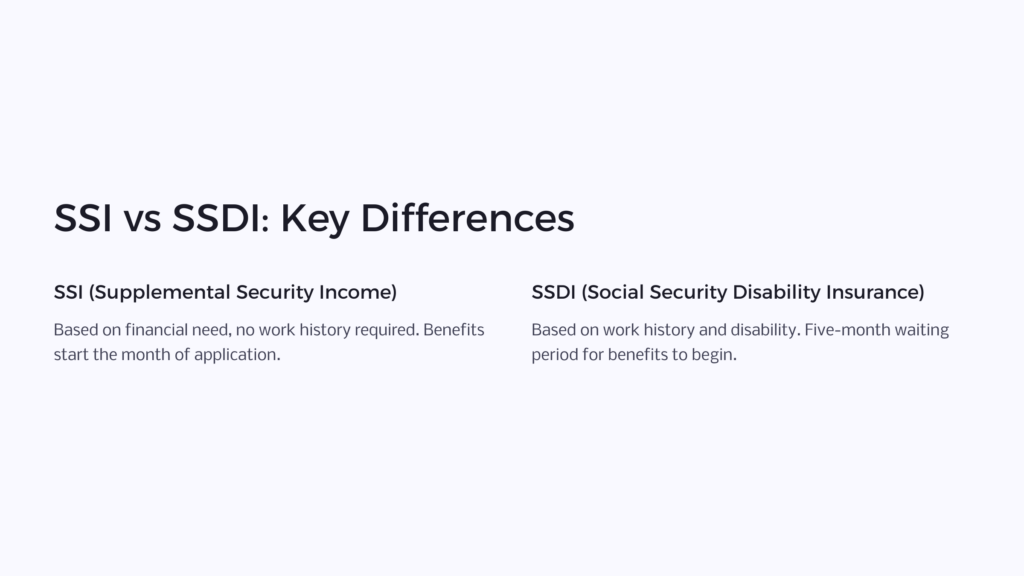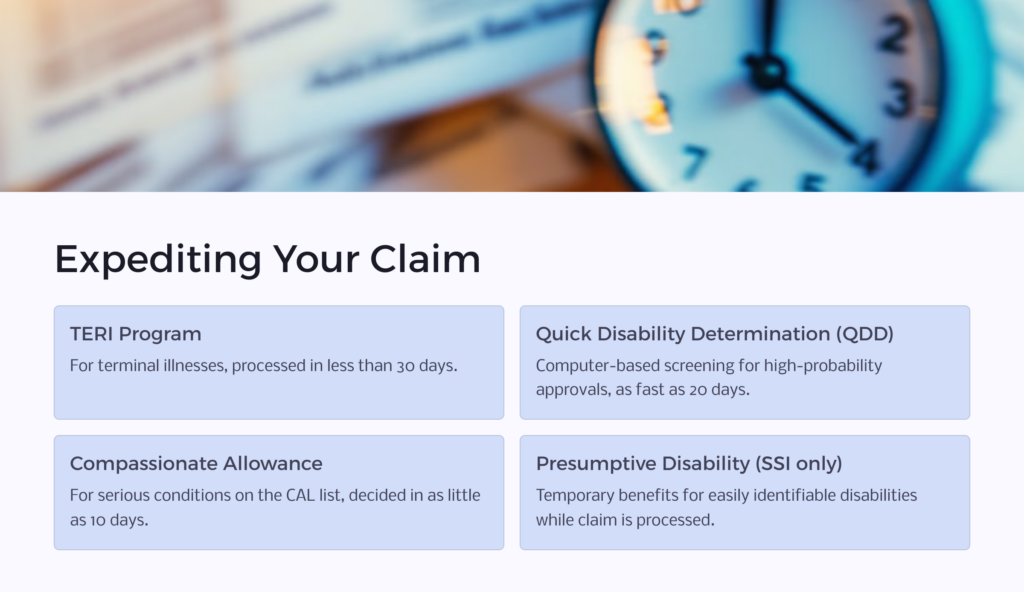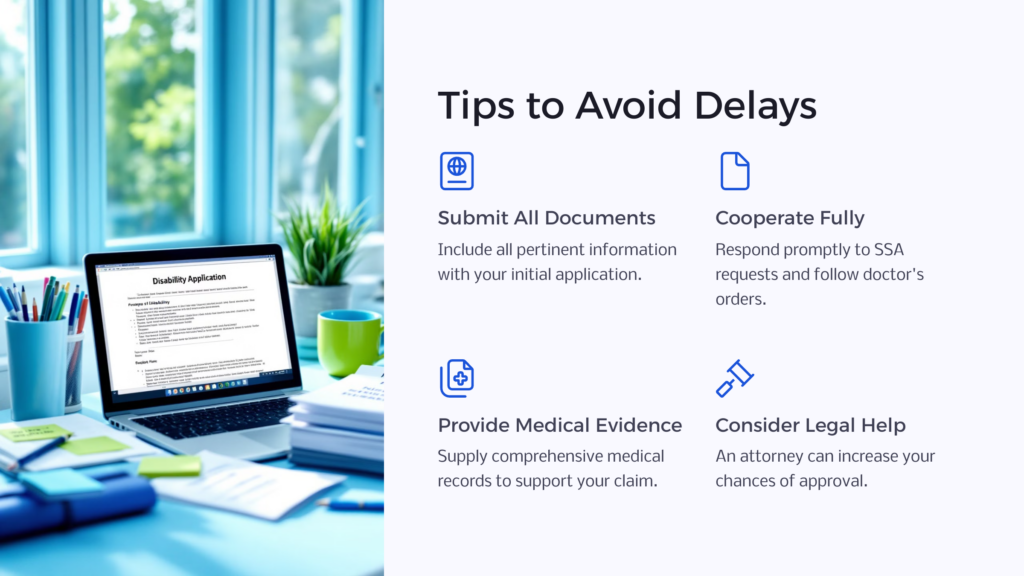While claims can turn around in a few months, many disability applicants must wait 12 or more months to get a disability hearing to overturn a denied claim.
Every day is difficult when you struggle with your health because you may also be under financial pressure. As a result, trying to maintain a reasonable semblance of your life is a constant challenge.
To help people in need, the Social Security Administration (SSA) has two programs that will provide financial assistance to ease the burdens placed upon those with debilitating physical and mental issues.
Supplemental Security Income (SSI) and Social Security Disability Insurance (SSDI) provide critical assistance for those who need it most.
But because each day is magnified when you are experiencing severe health issues, aside from qualifying for these programs, the most important question you are likely to have is how long it will take to be approved for benefits and when you will actually start seeing them.
What Are SSI and SSDI?

SSI and SSDI are sometimes confused with each other. However, while both provide much-needed benefits, each has a different set of criteria for approval and a different set of timelines regarding how long it will take before those benefits kick in.
Supplemental Security Income pays benefits to people who are disabled but who do not qualify for SSDI benefits because they have not worked and paid into the system or are very young students who have not yet entered the workforce. SSI is based strictly on need and for people 65 or older with very low incomes.
Social Security Disability Insurance pays benefits for people who have worked and paid into Social Security, and who have a disability that is expected to last at least one year or until they die.
Aside from qualifying for benefits, the biggest difference between the two programs is how long a recipient must wait before benefit payments start. SSI has no waiting period, and recipients can start getting benefits the same month they file a claim. On the other hand, SSDI has a five-month waiting period from when a person becomes disabled until they start getting benefits.
The other big difference between the two programs is health insurance. SSDI recipients must wait two years from the month they became eligible for Medicare coverage. On the other hand, SSI recipients can get Medicaid coverage as soon as they are approved for SSI benefits.
Steps of the Approval Process
- Review Work Status: The SSA checks if you’re earning above the substantial gainful activity limit.
- Assess Condition Severity: Disability must significantly limit basic work activities for at least 12 months.
- Check the Social Security’s Listing of Impairments: The SSA compares your condition to their list of disabling impairments.
- Evaluate Work Capacity: The SSA determines if you can do past work or any other type of work.
To better understand how long it might take to approve your claim, you should know how Social Security determines if a disability is severe enough to qualify for benefits.
SSA uses a sequential evaluation process for an initial review of disability applications, and this generally takes about eight to ten months for either program, assuming there are no red flags that can cause a delay. However, for both programs, exceptions to this process can expedite approval.
- SSA will review your current work status. Your claim will be rejected before your medical conditions are even considered if you work and earn more than a specified monthly amount. Social Security calls this substantial gainful activity (SGA). As of 2025, that amount is $1,620 per month, but it’s recalculated every year. If you are earning less than the specified monthly amount or not working at all, SSA will move on to the next steps.
- Determining the severity of your condition. To be considered severe, the disability must significantly limit the ability to perform basic work activities such as standing, walking, lifting, sitting, or remembering for a minimum of 12 months. For evaluation, SSA will turn your case over to Disability Determination Services (DDS).
- Is your medical condition listed in Social Security’s Listing of Impairments? SSA publishes a list of disabling conditions and circumstances that automatically meet the criteria for being considered disabled. Suppose your condition is in the Listing of Impairments, and you document it sufficiently with medical records. In that case, your application will move quickly through the approval process, minimizing the time it will take for approval.
- If your condition is not listed, DDS must establish whether or not your condition prevents you from performing any of your past work. If it can be shown that you cannot perform this type of work, then DDS will move on to the next step.
- Can you perform other kinds of work? DDS will consider your age, education, past work experience and any special skills you have to determine if you are qualified to do other work. You will be denied benefits if you can transition to other kinds of work. If you cannot transition, you have a better chance of getting your claim approved.
Speeding Up the Approval Process

It’s critical to understand the steps in the approval process because if you can meet these steps initially, you could save months and possibly a year or more in getting approved for benefits. Unfortunately, about 70% of applicants do not meet all the requirements, and their initial claims are rejected. So the best way to cut your approval time down is to submit your application the right way the first time.
However, you can also take circumstances and steps to speed up the approval process. For example, not all disability applicants have to go through the entire disability process the first time they file because Social Security streamlines cases to make decisions on claims that involve the most serious medical conditions.
Patients who have a terminal condition can have their claim expedited through the Terminal Illness Program (TERI). Field office representatives or a medical examiner at Disability Determination Services can submit a claim to the TERI program when a doctor or family member states the illness is expected to result in death or an applicant is in hospice care. TERI cases are usually processed in less than 30 days.
Some of the medical conditions that qualify for the TERI program include:
- Stage IV cancer, or cancer that is inoperable or has metastasized
- Cancer of the esophagus, liver, pancreas, gallbladder, or brain
- Small cell or oat cell lung cancer
- Mesothelioma
- Some forms of leukemia
- Chronic heart or pulmonary failure
- Comatose for more than 30 days
- A newborn with a congenital or fatal genetic defect
- Waiting on a liver, lung, heart, or bone marrow transplant
- AIDS
- ALS
The Quick Disability Determination (QDD) process allows SSA to process SSDI and SSI claims using a sophisticated computer modeling program. It analyzes an applicant’s electronic files for factors that show a high probability that they will be determined to be disabled. When a claim is chosen for QDD, a medical consultant does not need to look at your file, which is normally the case, and you could be approved for benefits in as little as 20 days. If your QDD claim is denied, then your claim will have to go through a longer approval process.
The Compassionate Allowance program allows for benefits to be decided upon in as little as 10 days. It is based on applicants with serious medical conditions that obviously qualify for benefits based on listings in Social Security’s Listing of Impairments. This program is reserved for the most seriously disabled applicants. SSA has compiled a Compassionate Allowance List (CAL), and if your disability or condition is on this list, you will be fast-tracked for approval. The key is ensuring that SSA has enough medical records in hand as quickly as possible to support the CAL claim. Typically, Compassionate Allowances include several types of cancer, ALS, muscular dystrophy, Alzheimer’s disease, and other similar health issues. (You can see the full CAL here).
For SSI benefits, Social Security can make temporary benefits available for some disabilities through the Presumptive Disability (PD) process. Benefits are available for the first six months while SSA reviews and processes a claim. Presumptive disability payments are not available for SSDI claims. For these cases, SSA looks at conditions where it is easy to assume a person has a qualifying disability and is therefore “presumed” to be disabled. This can include conditions such as cerebral palsy, total blindness or deafness, a spinal cord injury, amputation of two or more limbs, severe mental retardation, ALS, or terminal illness with less than six months or less to live. Other similar serious conditions are also considered, as long as reliable source medical information is provided.
If the SSA has not made a PD decision within six months, the presumptive disability payments will stop. If the SSA denies the disability claim, you are not responsible for repaying money received because of the presumptive disability.
Waiting on The Appeals Process
Just like no two applications are exactly alike, no two appeals are exactly alike either. Unfortunately, because as many as 70% of initial applications are rejected, appeals are quite common. Unfortunately, as you work through the various levels of appeal, it could add many months before your claim is finally approved.
The first level of appeal is known as a Reconsideration. Because a reconsideration looks at much of the same information already gathered during an initial application process, plus any new evidence or medical records you want to submit to bolster your claim, the average time for a decision on a Reconsideration is about 60 days. This length of time can vary up to six months depending on the case, what files are requested, and the complexity of the files to review.
You have 65 days from the time of your initial denial to start the appeal process. To do so, you must submit a Request for Reconsideration, Form SSA 561, an Appeal Disability Report, Form SSA 3441, and a Medical Release, Form SSA 827. Social Security will forward these forms to your particular state disability agency, most times known as Disability Determination Services, or DDS. However, each state may have a slightly different name for its agency.
If a Reconsideration is denied, the next step in the appeal process is a hearing in front of an Administrative Law Judge (ALJ).
In a hearing with an Administrative Law Judge a claimant and their attorney (if they have one) are responsible for gathering medical files to further support the claim for benefits. Much like a trial, there is an opportunity to present arguments and evidence supporting the claim and why it should be approved. Prior to the hearing, most judges will already be familiar with your case because they have reviewed case materials, so expect that the questions will be targeted and informed.
The good news is that about 50% of the time, hearing in front of ALJs result in approval. Unfortunately, it can take several months to get a hearing scheduled. For most disability applicants, this level of the disability process is the longest and most frustrating.
Due to large hearing backlogs, many disability applicants must wait 12 months or more to get a disability hearing. The exact length of time will depend on the backlog of cases in your area. There are ~1,300 ALJs in the United States, and they rule on an average of ~700,000 cases annually. After a judge makes a ruling, which typically takes 30 to 60 days, it must be submitted for a quality review before being mailed to the applicant.
Claimants who are denied in a hearing with an ALJ can file to have their case heard with an Appeals Council review. Applicants who take their claim to the Appeals Council for review may experience a wait time of two years. To improve your slim chances, you should definitely retain an attorney to assist you at this level.
The final level of appeal is to take your case to Federal court. Appealing to a Federal court may take more than a year after the Appeals Council process has been completed. If you are going to this level, you should also file a new initial claim, as there are few reversals of ALJ decisions at the FDC level.
How Long Does it Take to Receive Back Pay After Approval?
Social Security disability claimants typically have to wait one to two months after approval before seeing their first SSDI monthly payment. After that, it may take even longer to receive back pay.
If you haven’t started receiving your benefits within 90 days of approval, contact the SSA. If you have a lawyer, have them contact the SSA for faster results. A Social Security disability lawyer can often navigate the red tape much faster than a claimant.
The good news is that even if your approval process takes a long time, you can be eligible for back pay once your claim is approved. While this does little to ease your financial pressures if you are going through a long and drawn-out approval process, if you can hold on long enough, you can get back pay benefits dating back up to 12 months before the date of your application, assuming you meet all requirements.
In most cases, you should be able to receive back pay, or an installment of back pay, within 60 days of being approved for benefits.
In some cases, SSA will begin current monthly payments for SSDI benefits you have been awarded, but not back payments, because they will need to investigate to see if you received any SSI benefits when your application was under review.
Most recipients receive their benefits “check” through direct deposit into their bank account. Those who don’t want to receive their benefits through direct deposit, the SSA offers a debit card as an alternative form of payment.
Other Reasons For Delay

You want to be approved for benefits as quickly as possible, but in many cases, you may be the reason why there is a delay, sometimes a lengthy one, in having your benefits approved. Here are several things you can do to help speed your approval process along:
Submit ALL pertinent documents with your initial application. Ensure you are thorough by including a birth certificate, a complete medical history, establishing records, including detailed information on where and with whom you have received treatment, a work history, asset and income records, and any other important information that will help your case.
Make sure you meet non-medical requirements. Essentially this means you are limited in the income you can earn. If you go over this amount ($1,620 in 2025), you will be denied.
Meet the definitions for a medical disability. Your condition must prevent you from working, and it must be permanent enough that you will not be able to work for a year or more, or it will result in your death.
Cooperate with Social Security. If they ask for more documents, provide them. If you move, give them your new address. If you are asked to come in for an interview or consultative exam, do so as soon as possible.
Cooperate with your doctor. If you do not follow the treatment your doctor has prescribed for you, this will be a major red flag for your disability application. Work with your doctor instead of ignoring him or fighting against him.
Complete all of your submission forms. Be patient. There are a lot of them. And every one of them needs to be completed.
Make sure your disability is not primarily due to alcohol or drug use. If you are suffering from alcohol or drug abuse, which is the primary reason that prevents you from working, you will not be able to collect benefits. However, you can still receive benefits for conditions caused by alcohol or drugs, but it just can’t be the main contributing factor to your illness.
Make sure you were not previously denied SSDI benefits. Some applicants believe they can wipe the slate clean and fill out a new disability claim, and that it is a better route to go than appealing a currently denied claim. Unfortunately, this may raise a red flag for a claims rep who sees that you applied for an SSDI claim and were denied benefits before, especially if important deadlines have passed.
Supply enough medical evidence to back your claim. Collect every bit of medical evidence that you can to support your claim. SSA relies heavily on medical records; the more you submit, the more you enhance the likelihood of approval.
Do not commit fraud. If you get caught trying to cheat the government, you will be denied benefits, and you might also face criminal charges.
If you are denied benefits, file an appeal as soon as possible. An appeal will take some time to work through, and the sooner you file for an appeal, the closer you will be to ultimately winning benefits.
Retain an attorney. Statistics show that you stand a much greater chance of approval if you hire an attorney to help you with your case. Many attorneys handle SSDI cases and can help you with several parts of the process. For example, an attorney can help you apply, gather paperwork, respond to requests by SSA along the way, and, if needed, represent you at your hearing.
How do I apply for disability benefits?
- You can apply Online. As part of this process, you will need to print and review SSA’s Adult Disability Checklist. It will help you gather the necessary information to complete the Disability Benefit Application.
- Over the phone by calling 800-772-1213.
- In person at your local Social Security office. Find your local office.
How To Determine Your Social Security Disability Benefits Amount
Several sources you can access will provide you with a Social Security Disability Insurance benefits calculator. In addition, you can get an overview of the process of how SSDI benefits are calculated by checking out the official Social Security list here.
We at Benefits.com are here to help you, however possible, in your journey to receiving the benefits you deserve. Begin today by taking our free eligibility quiz.
 Benefits.com Advisors
Benefits.com Advisors
With expertise spanning local, state, and federal benefit programs, our team is dedicated to guiding individuals towards the perfect program tailored to their unique circumstances.
Rise to the top with Peak Benefits!
Join our Peak Benefits Newsletter for the latest news, resources, and offers on all things government benefits.





















